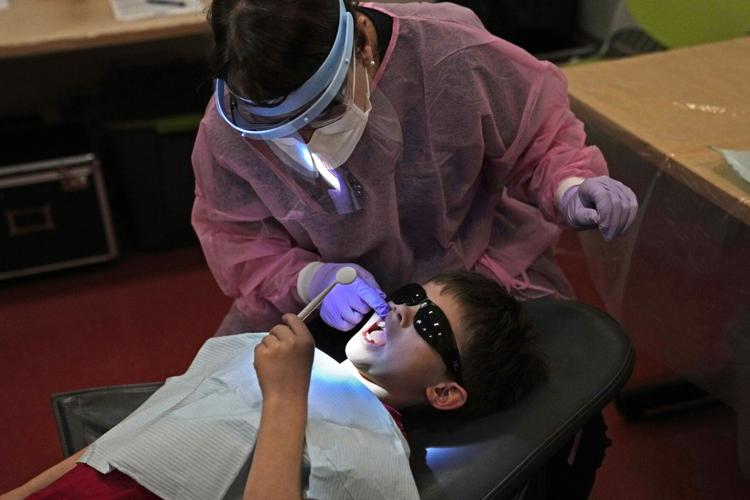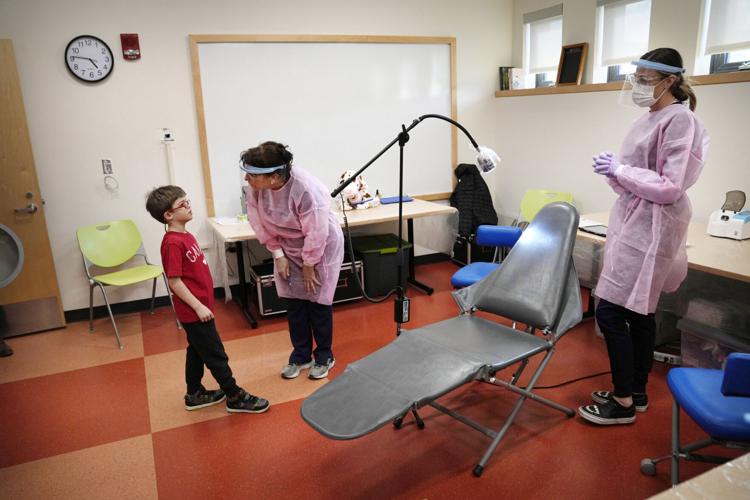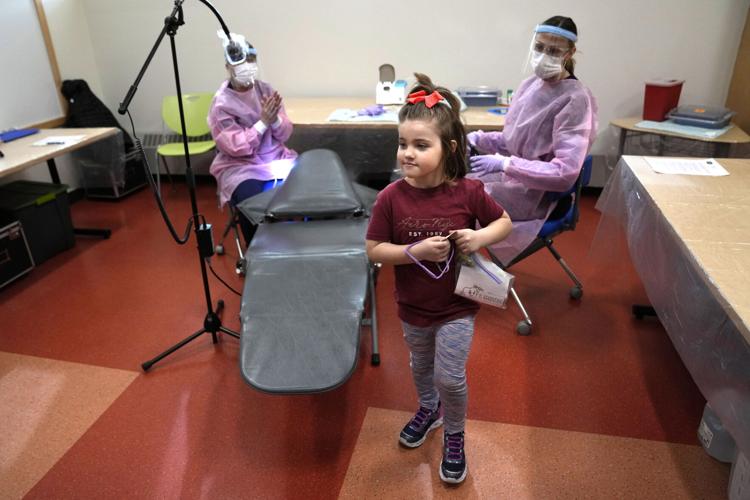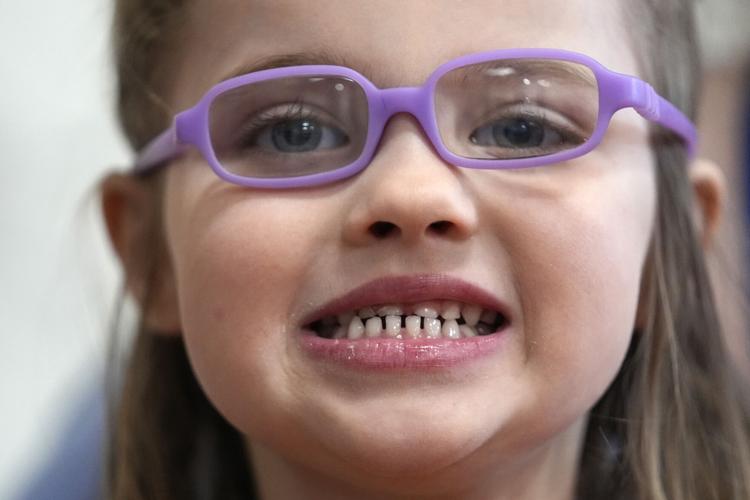CONCORD, N.H. — Tucked away inside the teachers lounge at a New Hampshire elementary school, Amber Warner was having her teeth checked out for the first time.
The 5-year-old sat back on what looked like a beach chair and wore a pair of dark sunglasses as certified public health dental hygienist Mary Davis surveyed Amber's teeth and then with a tiny syringe applied traditional dental sealants, which had the consistency of nail gel.
“Close down and bite your teeth together, bite down like you are biting down on a hot dog or a cheeseburger," Davis told Amber, to ensure the sealants were done properly. After that, Davis flossed all of the “popcorn and the chicken, pizza between your teeth.” The whole visit took 15 minutes.

Amber Warner leaves the chair after a dental exam Feb. 21 at the Christa McAuliffe School in Concord, N.H.
“Look at you. You are a pro on your first dental visit. I am so proud of you,” Davis said to the kindergartener, who got up from the chair and was hugged by a teacher's assistant.
People are also reading…
The portable clinic is part of a cavity prevention program developed by NYU College of Dentistry and being rolled out in Concord and two other New Hampshire districts. CariedAway New Hampshire hopes to expand to Maine and Vermont — and eventually nationwide — as part of a growing effort to improve pediatric oral health, especially in children from lower-income families.
There isn't a good national estimate of dental programs in schools but many larger school districts have them. Boston University’s program operates in 20 schools and 30 preschools in Boston and eight other cities in Massachusetts and covers 3,000 children from 6 months to 21 years. In New York City, 81,000 students across 820 schools — a little over half of all public schools — were treated last school year.

Clayton Warner holds a mirror as dental hygienist Mary Davis examines his teeth Feb. 21 at the Christa McAuliffe School in Concord, N.H. School-based care centers and nonprofits are trying to shore up teeth that may have been neglected during the pandemic or haven't received routine dental care.
Nationwide Children’s Hospital has seen 1,700 children in central Ohio since 2021 with its roving school-based dental clinics, while Minnesota nonprofit Ready, Set, Smile is in 44 schools in the Twin Cities, serving 2,225 children.
“Dental care typically is looked at as an extra or an add-on,” said Terri Chandler, who is the founder and executive director of Future Smiles in Clark County, Nevada, which includes Las Vegas and serves 7,500 kids in 75 schools. “It is not part of medical care.”
Nearly half of all U.S. children don’t receive regular dental care, according to a 2022 report from the National Institute of Dental and Craniofacial Research, which is a federal agency.
That can lead to cavities quickly: More than half of children ages 6 to 8 had a cavity in at least one baby tooth and more than half adolescents ages 12 to 19 have a cavity in at least one of the permanent teeth, according to the U.S. Centers for Disease Control and Prevention.
Too many children fail to see a dentist before they enter school — forcing them to go to the hospital to get treatment for a mouthful of cavities, Harvard School of Dental Medicine's Catherine Hayes said.

Amber Warner shows off her teeth after a dental exam Feb. 21 at the Christa McAuliffe School in Concord, N.H.
“If their parents aren’t getting any kind of oral health education in the physician’s office, these kids develop extensive decay,” she said, noting it can take a month or more to fix. She added: "... It's completely preventable. We know how to prevent it.”
At Boston Children’s Hospital, there's a waiting list of eight to nine months for the dental clinic, said Man Wai Ng, the dentist-in-chief. Ng points in part to worsening dental care during the pandemic.
“I have patients who were going to bed without brushing their teeth. They ate and drank at all hours of the day because those normal daily routines weren’t there,” Ng said. “They weren’t able to get in for ... preventive dental care. Kids were developing more dental disease without the ability to get timely care.”
Ruth Langwell struggled to find a dentist for her granddaughter Lola, a 10-year-old who has autism. She recently was able to get the girl into the clinic.
“She needs somebody who is very patient, obviously … We've tried two other dentist and they have been reluctant because of Lola's challenges," said Langwell, who added she wanted Lola to see a dentist at age 2, but didn't until she was 5.

Clayton Warner is greeted by dental hygienist Mary Davis before a dental exam Feb. 21 at the Christa McAuliffe School in Concord, N.H. Dental assistant Crystal Muzzo stands at right.
The challenge for many programs, especially mobile and school-based clinics, is sustainability, said Richard Niederman, a professor of epidemiology and health promotion at NYU Dentistry and founder of CariedAway. That's because school-based programs like Neiderman's lean heavily on donations because they often serve low-income populations who are either uninsured or on Medicaid.
Niederman spent two decades developing his program. Other ones he tried in the Bronx and Boston ended due to a lack of funding, but this time, Niederman has $1 million from Northeast Delta Dental, which ensures his New Hampshire program will remain in place for at least three years.
“It breaks my heart that kids don’t get effective care that they could get … and the system doesn't support it,” he said.
But the picture for pediatric oral health is improving — even outside of school programs.
Untreated tooth decay in preschool children is down 50% since 2000, according to the federal dental research agency's report. It pointed to an increased use of sealants, which prevent cavities.
Changes in child tax credit would have outsized impact on rural children
Changes in child tax credit would have outsized impact on rural children

The families of more than a quarter of all children living in rural America would benefit from a proposed expansion of the Child Tax Credit that has passed the U.S. House of Representatives and is now under consideration in the Senate.
The Daily Yonder takes a closer look at how the expansion would change the credit's eligibility criteria to include low-income families who don't get the full tax credit per child because they don't pay enough taxes to qualify. The current credit phases in until family earnings reach a certain threshold. Most low-income families – usually ones who make under $40,000 annually – receive partial or no credit.
"Because of that structure, it particularly disadvantages children who live in rural areas largely because pay is typically lower in rural areas," said Stephanie Hingtgen, research analyst at the Center on Budget and Policy Priorities. "Clearly this is upside down."
Under the proposed legislation, more than 80% of the children who don't get the full credit would see a boost in their family's income from the credit, according to Hingtgen. The legislation would also increase the credit slightly, from $2,000 to $2,100 per child.

Expanded child tax credit would reduce stress

A study from a Harvard University research center found that when families are given a higher child tax credit – as they were in 2021 during the temporary Covid-19 pandemic relief effort – depression and anxiety rates among parents were lower, possibly because of reduced financial worries.
An estimated 27% of all rural children would benefit from the proposed expansion, compared to 22% in metropolitan areas, according to Center on Budget and Policy Priorities data.
The benefits could be even larger for rural families of color, who on average earn less than white families. In rural areas, 46% of Black children, 39% of Latino children, and 37% of American Indian and Alaskan Native children would receive more money under the Child Tax Credit expansion. For each demographic group, a significantly higher proportion of children from rural areas would benefit than children from urban areas, the analysis showed.
Last week, the House of Representatives passed the legislation in a rare bipartisan vote. Now the Child Tax Credit expansion is being considered by the Senate. If passed, the change would go into effect for the current tax filing season (2023) and continue for three years, ending after the 2025 filing season.
"This is Congress' only shot this year to pass legislation that would substantially boost the incomes of millions of children and families with low incomes and substantially lower child poverty," Hingtgen said.
This story was produced by The Daily Yonder and reviewed and distributed by Stacker Media.














